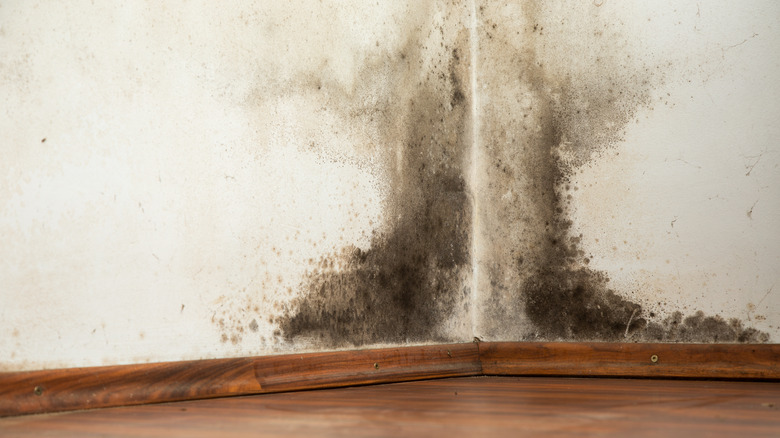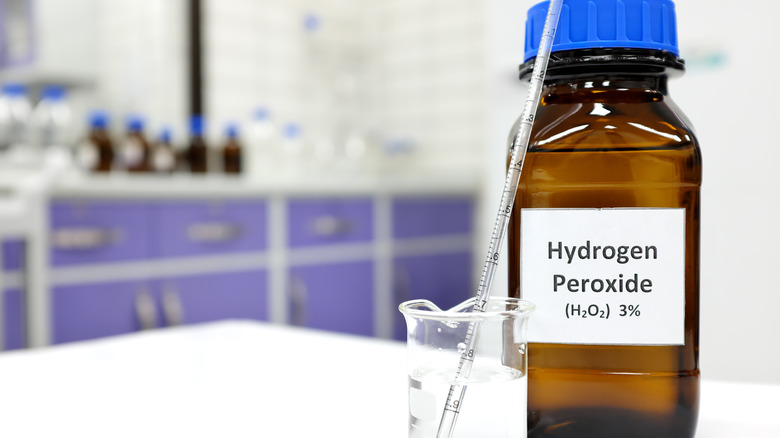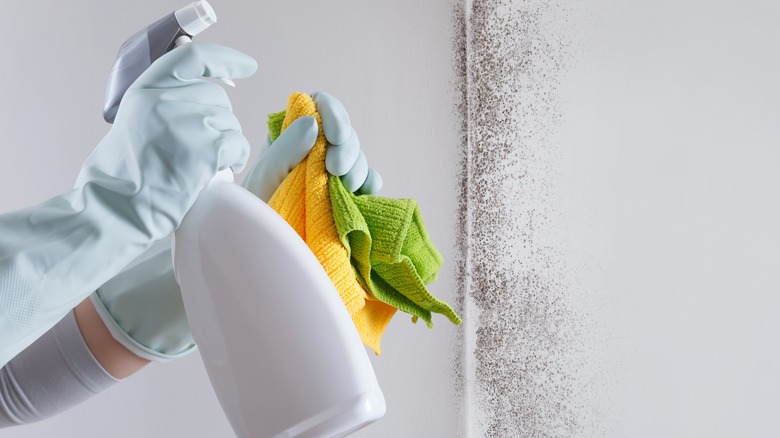Is Hydrogen Peroxide Strong Enough To Tackle Black Mold Around The House?
Once you identify mold in your home and determine it's black, how do you remove it? References to "black mold" actually refer to a variety of fungi species, not a singular type. The term is often used for Stachybotrys chartarum, which grows in warm, humid areas and feeds on moisture. If there's little ventilation present, it's the perfect storm for black mold growth. Luckily, you can remove black mold with the hydrogen peroxide, which is an antiseptic — a substance that reduces or stops microbial growth. It works when the fungi are on solid surfaces, but is not as effective on porous areas.
The fungi world features over 100,000 species of mold, but we most commonly hear about black varieties like Stachybotrys chartarum. Like its name implies, it has a dark appearance with tinges of blackish-green, with a fuzzy or flat texture and a musty smell. Its airborne spores can cause reactions such as coughing, stuffy nose, itchy watery eyes, and other symptoms similar to a cold. Exposure to black mold can also worsen symptoms in asthmatic patients and trigger respiratory symptoms, including shortness of breath. Here's how you can use hydrogen peroxide to tackle it.
How to treat and kill mold with hydrogen peroxide
In a 2013 study in The Journal of Occupational and Environmental Hygiene, researchers concluded a treatment of hydrogen peroxide can prevent Stachybotrys chartarum growth and spore germination. The antiseptic is best used on small patches of mold on hard surfaces. Per the Environmental Protection Agency (EPA), this means a patch of less than roughly 3 feet by 3 feet. In other words, if your entire bathroom is caked with mold, you're better off calling a mold removal professional. For other cases, you can use 3% hydrogen peroxide to kill and remove the fungus.
Before treating black mold, make sure you've stopped the moisture source (i.e. a leaky pipe) and have proper ventilation. Be sure to wear gloves and goggles to protect against the fungal spores. Now, pour the hydrogen peroxide into a spray bottle, then liberally spray the mold spots. The antiseptic will begin bubbling, breaking down the fungi's protein and DNA while it works. Wait until the bubbles subside, then scrub the remnants away with a soft cloth or brush. If that doesn't remove all of the mold, then repeat the process. Just remember: It might seem easy to remove the fungus with this common household ingredient, but you should still be careful when working with it and other antimicrobial agents.
Precautions for using hydrogen peroxide to kill black mold
While there are other easy ways to clean mold, such as with vinegar and bleach, you should avoid directly mixing hydrogen peroxide with any of these substances. In particular, mixing hydrogen peroxide with vinegar can create peracetic acid, or peroxyacetic acid. The chemical can make your eyes tear, irritate your respiratory tract, and cause throat discomfort.
After you treat the mold, remove your clothing and wash it as soon as possible to avoid breathing in airborne spores you came into contact with or collected on your clothing. Once the area is dry, run an air purifier with a HEPA filter to help with the airborne spores. Besides running this appliance, you can invest in a dehumidifier to reduce moisture in the air and follow other tips for preventing mold from entering your home. This fungus can form within 24 to 48 hours on water-damaged areas, so it's crucial to take proactive steps to reduce its growth.


